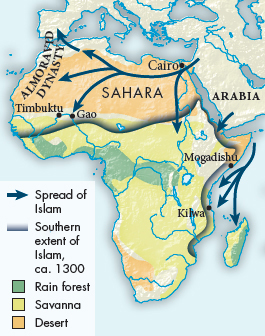The Spread of Islam in Africa

Perhaps the most influential consequence of the trans-
Conversion to Islam introduced West Africans to a rich and sophisticated culture. By the late eleventh century Muslims were guiding the ruler of Ghana in the operation of his administrative machinery. Because efficient government depends on keeping and preserving records, Islam’s arrival in West Africa marked the advent of written documents there. Arab Muslims also taught Ghana’s rulers how to manufacture bricks, and royal palaces and mosques began to be built of brick. African rulers corresponded with Arab and North African Muslim architects, theologians, and other intellectuals, who advised them on statecraft and religion. Islam accelerated the development of the West African empires of the ninth through fifteenth centuries.
After the Muslim conquest of Egypt in 642 (see “Islam’s Spread Beyond Arabia” in Chapter 9), Islam spread southward from Egypt up the Nile Valley and west to Darfur and Wadai. This Muslim penetration came not suddenly by military force but, as in the trans-
Muslim expansion from the Arabian peninsula across the Red Sea to the Horn of Africa, then southward along the coast of East Africa, represents a third direction of Islam’s growth in Africa. From ports on the Red Sea and the Gulf of Aden, maritime trade carried Islam to East Africa and the Indian Ocean. Muslims founded the port city of Mogadishu between the eighth and tenth centuries, today Somalia’s capital. In the twelfth century Mogadishu developed into a Muslim sultanate. Archaeological evidence, confirmed by Arabic sources, reveals a rapid Islamic expansion along Africa’s east coast in the thirteenth century as far south as Kilwa, where Ibn Battuta visited a center for Islamic law in 1331.
>QUICK REVIEW
What connections were there between trade and the spread of Islam in Africa?